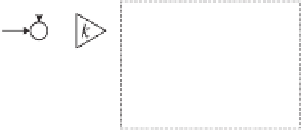Environmental Engineering Reference
In-Depth Information
-
-
θ
αβ
θ
θ
θ
θ
Figure 22.5
SOGI-based single-phase PLL
˙
ω
=
θ
where
is the resonant frequency of the SOGI-QSG, and the transfer function
G
q
(
s
)
v
from
to
e
q
is
2
k
ω
G
q
(
s
)
=
2
.
(22.6)
s
2
+
k
ω
s
+
ω
Both
G
d
(
s
) and
G
q
(
s
) are resonant filters for 0
≤
k
<
2 and are able to select the component
of
v
at the resonant frequency
ω
.For
s
=
j
ω
,
G
d
=
1 and
G
q
=−
j
, which means
e
=
v
and
but the phase is 90
◦
delayed. When the frequency moves away
e
q
has the same amplitude as
v
and
G
q
decrease, depending on the gain
k
. As a result, only the fundamental
frequency component can pass the SOGI-QSG. A smaller gain
k
leads to better selectivity and
offers better attenuation to other frequency components but it takes longer to settle down.
Another important characteristics of SOGI-QSG is that
e
q
is always 90
◦
delayed, at any
frequency, from
e
because
|
G
d
|
from
ω
,
s
ω
G
d
(
s
)
=
G
q
(
s
)
,
which means the SOGI-QSG always generates two perpendicular components
e
and
e
q
,atthe
frequency of
.
The SOGI-QSG can be plugged into the typical single-phase PLL shown in Figure 22.4 to
form a SOGI-PLL as shown in Figure 22.5(b). The components
e
and
e
q
are treated as
ω
v
α
and
v
β
, which are further transformed into DC components
V
d
and
V
q
using the Park transformation
(22.3). A PI controller is used to drive
V
q
to zero. The output of the PI controller is added with
the nominal frequency
˙
θ
n
to form the estimated frequency
˙
θ
, which is then integrated to obtain
. Note that the estimated frequency
˙
the estimated phase angle
is fed back to the SOGI-QSG
so that it is able to select the component at the right frequency. When the phase is locked,
θ
θ












































Search WWH ::

Custom Search